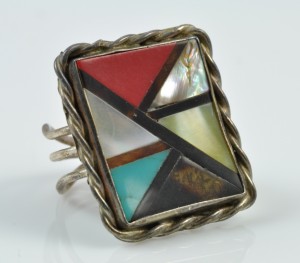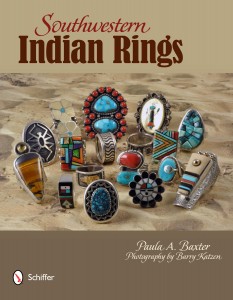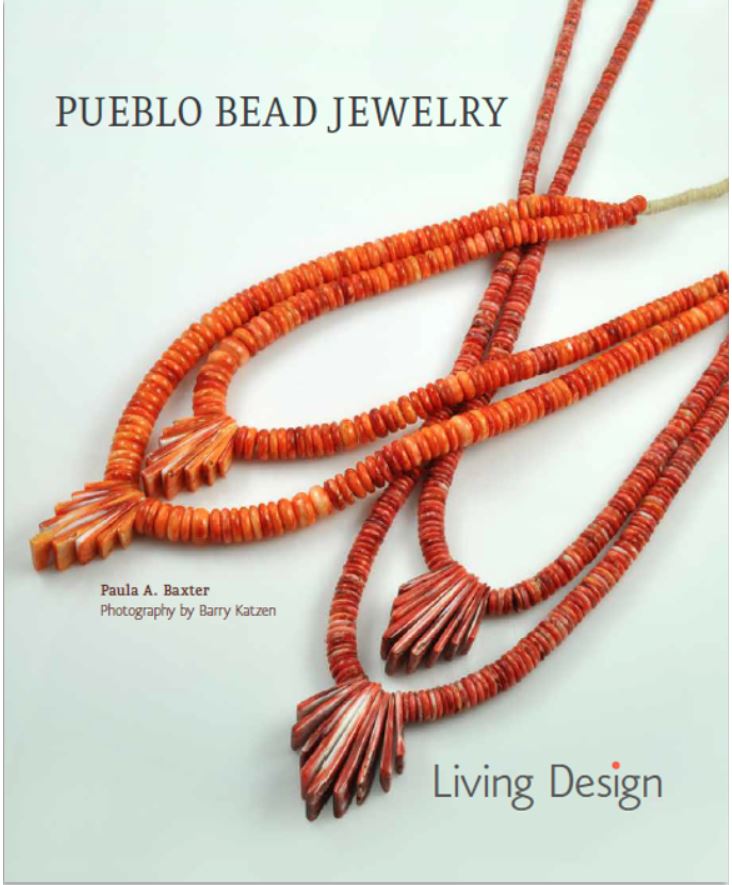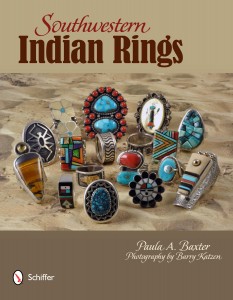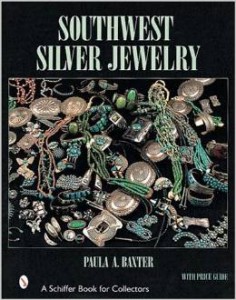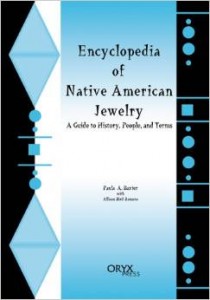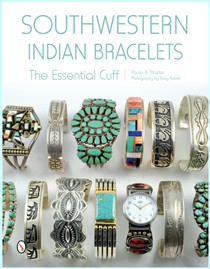What traveler to New Mexico ever fails to wonder at the state’s matchless clouds? In a recent visit we discovered it was easier to park along Old Town’s plaza and narrow streets than previously. Later on we heard that this part of the city has attracted gangs and petty crime. It made me glad we decided to park in the thick of things instead of the back parking lots.
One of the most venerable of Old Town’s attractions is the Covered Wagon, which has been selling Southwestern souvenirs since the 1940s. Its Indian arts are Route 66 curio goods, but the store remains fun and good-natured. If you have time for only one place in Old Town, check this store out. The best Indian arts on offer in Old Town are pottery and there are at least four fine shops to serve collectors and enthusiasts.
This year we finally ventured into Old Town Antiques, an interesting little shop with some good vintage jewelry. We also discovered through a friend a previously well-hidden treat, the restaurant Seasons. To better understand Old Town’s enduring appeal, check out the city’s history exhibits at the nearby Albuquerque Museum.
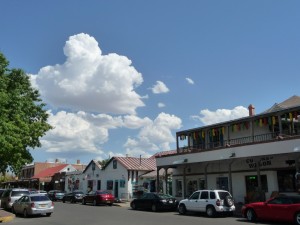 August clouds over Old Town Albuquerque, and the Covered Wagon.
August clouds over Old Town Albuquerque, and the Covered Wagon.
Albuquerque is in Indian Country and the evolution of Pueblo Deco is one of the region’s more enjoyable architectural feats. There is an interesting connection between Indian arts and the Art Deco era. Although Art Deco began in France, its character changed when translated to a different country. In the United States, Art Deco is a proud mode for New York’s skyscrapers and other eastern public works and apartment buildings. When the style came to the Southwest, its creators saw an immediate affinity with indigenous architecture and building details.
The KiMo Theater on Central Avenue is one of the best examples of Pueblo Deco, and echoes can be found in other buildings up and down Central. Art Deco was an excellent style for appropriating folk and local imagery, using cheerful colors, and providing just the right amount of razzle-dazzle to perk up any neighborhood. Its exotic modernity makes downtown Albuquerque even more intriguing.
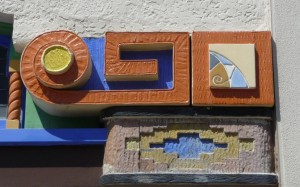 Detail of Pueblo Deco ornament on the KiMo Theater
Detail of Pueblo Deco ornament on the KiMo Theater
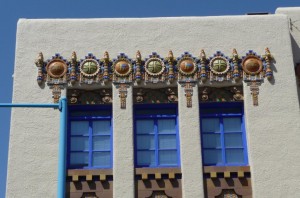 The KiMo Theater in downtown Albuquerque, NM
The KiMo Theater in downtown Albuquerque, NM
Over the years I’ve been collecting Indian arts, I’ve occasionally run into individuals who express fascination with Native-made medicine bundles. Most of the time this interest stems from the New Age-shamanistic appreciation of American Indians; it’s a forlorn hope not to expect some of this starry-eyed attitude on the part of non-Indians. It’s certainly true that many spiritual beliefs from Native culture are beautiful, and attractive to pursue.
But I always cringe when I learn that some people believe medicine bundles made for Native individuals are yet another category of collectible. Genuine medicine bundles are made for a specific person, blessed, and have efficacy only for the person who carries them. This “power” is not transferable to any other persons, Native or otherwise. The materials that go into medicine bundles of earlier decades can include remarkable fetish-like carvings. Nevertheless, the collecting of medicine bundles isn’t appropriate. There are those who tell me and others, in quiet tones, that such an acquisition can bring ill luck to the collector.
Another major point to consider: almost all the medicine bundles available on the market are bogus. Don’t go there.
 Gallup evening clouds
Gallup evening clouds
In the first year I started collecting, I consulted a Navajo gallery dealer about an overriding concern: I was not a collector with a lot of money. She understood my dilemma and questioned me about my passion for Southwestern Indian jewelry. After some discussion, she suggested I collect Indian rings. These items were not as expensive as other jewelry and could be picked up for reasonable prices. She also encouraged me to buy rings from young makers who might, in time, become notable artists.
As I studied the history of Indian design, I realized a significant change had occurred in the 1960s. Young Native artists had a chance to study together at the Institute of American Indian Arts in Santa Fe. They also took in other museums, and absorbed mainstream art history as part of their learning experience. I found this ring at Brimfield Market in Massachusetts in the early 1990s; the dealer assured me it was Indian-made. I’m sure he was correct, and I knew (after working there for five years in the 1980s) the very painting gallery room at the Museum of Modern Art where the ring’s maker drew his or her inspiration.
We’ve only been there once, but we will never forget Three Turkey Ruin, situated off the Canyon de Chelley perimeter road. The remnants of a nineteen room Ancestral Puebloan cliff dwelling can be accessed on a dirt road. If you peruse the Indian Country road map, this dirt road veers east and also provides a short cut to Fort Defiance; this drive is more direct than going around the main paved roads to Ganado and then east to Window Rock.
We made the mistake of taking this dirt road one late autumn afternoon, already dwindling into dusk. Recent rain and snow had created a soupy coating of mud on the road that threatened to bog down our four wheel drive. As night fell, the lack of lights around us and the fact that we were going through tree-filled wilderness, fueled our unease. Small paths split off to habitations we couldn’t see, the mud sucked at our wheels like quicksand and our hearts thudded with growing panic. Our car would bog down miles from anywhere and no one else would be traversing this road. My husband floored the vehicle, afraid to brake, and we kept going on a road that seemed to climb at an elevation. Just when we felt the first pangs of real terror, the road hit pavement. We’d made Fort Defiance.
I remember us eating a celebratory taco dinner at the Navajo Nation Motor Inn. I suspect others have an adventure like this to report. It taught us one thing, for sure. Never travel a road because it seems like a good shortcut!
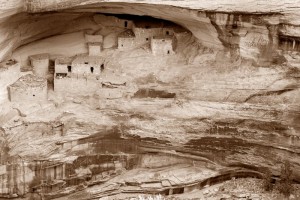 Three Turkey Ruin (from dawnKIS photography: http://bit.ly/T4EtPt)
Three Turkey Ruin (from dawnKIS photography: http://bit.ly/T4EtPt)
For years we traveled along the interstate to and from Albuquerque, stopping off at the ratty Dairy Queen located at Rio Puerco. The rest stop is the first real one you reach either just before cresting the hills to see Albuquerque sprawled ahead or after leaving the city and its towering peaks behind. This summer we came from the west and discovered a gleaming casino in what was once a care-worn relic of Route 66. (The appropriately named Route 66 Casino Hotel is operated by Laguna Pueblo.) But the Dairy Queen is still there, surrounded by shiny chrome walls and all the elements of a first-rate truck stop. The tacky souvenirs were intact, too — just better housed. Ah, progress!
(Historic note: On the other side of I-40, on old Route 66, is the historic Rio Puerco Bidge, maintained by the National Park Service.)
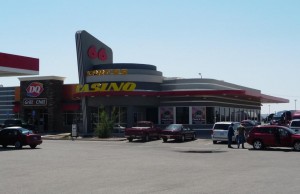 The new Dairy Queen at Rio Puerco, along Route I-40, part of the Route 66 Casino. Photo © 2012 by Barry Katzen
The new Dairy Queen at Rio Puerco, along Route I-40, part of the Route 66 Casino. Photo © 2012 by Barry Katzen
The 2008-9 Great Recession threw many non-profit cultural institutions into a tailspin; funding curtailments brought big changes to operations that had always maintained some measure of continuity. Almost overnight, these organizations discovered that they needed to apply business solutions; some places succeeded in making transitions, while others ended up damaging aspects of their original mission. The Gallup Ceremonial’s problems don’t stem simply from a lack of cash. The event needs to reevaluate the state of Indian arts today, what requirements drive local tourism, and how aiding the local community can be balanced with bringing in more visitors who want to see and participate in something unique and special.
What worked well from the 1920s up to the last quarter of the twentieth century no longer meets the demands of the 21st century. That doesn’t mean throwing out the baby with the bath water, however. The Ceremonial’s directors and sponsors need a new vision of just what can refresh its traditions while creating an added impetus for attending. What exactly brings locals and visitors together? In the past, those who respected Indian culture (like me) enjoyed coming to partake of things that wouldn’t ordinarily be available when just passing through as a tourist.
One idea I hear from those who live in or near Gallup is that the Ceremonial needs to be brought back to downtown Gallup. The SWAIA Indian Market benefits greatly from being held on Santa Fe’s Plaza and adjoining streets. The aura of street festival is hard to beat, and Red Rock Park’s buildings look very tired and in need of structural reinforcement. A place to begin is with the bathrooms: the facilities in Gallup’s busy WalMart look much better than those at the park…
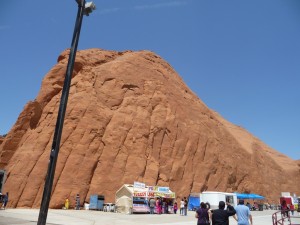 At the entrance to the Gallup Inter-Tribal Ceremonial
At the entrance to the Gallup Inter-Tribal Ceremonial
Nevertheless, the Ceremonial isn’t dead yet, not by a long road. There are those still loyal to its original premise when founded in the 1920s, that this would be an important venue for Indian arts at their best. What many people forget, also, is that this is an event for bringing Native peoples together. I might prefer a powwow to a rodeo, but there’s entertainment for the locals and the venue can be a source of pride—a destination. I certainly saw this on Saturday morning when we pulled onto I-40 and glimpsed the large, healthy crowd downtown for the parade.
Back in the 1930s, the Indian traders held sway. Newspaper articles in following decades largely gave Native artists short shrift and reported on which trader booth had received the most awards for arts. Patronage has changed, and the list of corporate sponsors is a telling statement about what businesses today can afford to be sponsors. The Arts judges are also leading figures in the field. Later that week,in Santa Fe, I spoke with one judge who expressed some concern about the changing of categories for prizes. This created difficulties for some artists. For example, I saw fewer entries from Zunis than expected. It may be that the Ceremonials sponsors need to clarify and establish less flexible guidelines and attempt a wider range of fundraising.
My summer in the Southwest yielded other stories about institutions reorganizing, sometimes in rather alarming fashion. I discovered in Santa Fe that the Indian Arts and Crafts Association (IACA) had recently eliminated its paid staff for an all-volunteer staff.
 At the entrance to the Gallup Inter-Tribal Ceremonial in Red Rock Park
At the entrance to the Gallup Inter-Tribal Ceremonial in Red Rock Park
This question has often come up over the years. This year, we were in a position to attend and pulled into the parking lot for the Friday August 9 day of the annual event. There were a lot fewer cars than we remembered. An immediate disappointment arose when we bought our tickets and learned that the powwow had been canceled. The booths along the perimeter of the buildings had Natives selling stuff that was definitely NOT locally made. Inside, things seemed back to normal except for the fact that the interior booths were reduced to a very small number. I remember when the booths lined the entire perimeter of the great hall.
Can we blame the recession? Yes, but there seems to be a more complex string of issues. Those who run and organize the Ceremonial have been plagued by fundraising woes. I recall about five years ago they turned to the state for funding solutions. Ooops! One reality is that the number of active trading posts with powerful followings of artists and collectors has greatly diminished. Trading posts are not what they once were, and Hubbell Trading Post in Ganado AZ may soon be one of the few real remaining relics of this enterprise.
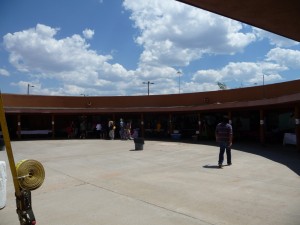 The outdoor booths at the Gallup Inter-Tribal Ceremonial.
The outdoor booths at the Gallup Inter-Tribal Ceremonial.
Join us for a book signing of Southwestern Indian Rings!
When: Thursday, August 16, 5 pm.
Where: Collected Works Bookstore, 202 Galisteo Street, Santa Fe.
We’d love to see you there!
